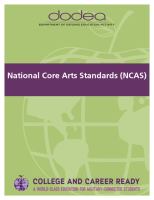

National Core Arts Standards (NCAS)
Arts Education Standards and 21
st
Century Skills - cont.
Communication
Communication lies at the heart of the arts. In studying the arts, students develop a vast repertoire of
skills in intrapersonal and interpersonal processing, listening, observing, speaking, questioning, analyz-
ing, and evaluating meaning. Use of these processes is developmental and transfers to all areas of life:
home, school, community, work, and beyond. It is through communication that collaboration and coop-
eration occur.
In learning to communicate through the arts in a standards-based curriculum, students learn to:
Video: The Importance of Theatre Arts for Children
Articulate thoughts and ideas effectively using oral, written and nonverbal communication skills in
a variety of forms and contexts.
Look and listen effectively to decipher meaning, including knowledge, values, attitudes and inten-
tions.
Use communication for a range of purposes (e.g. to inform, instruct, motivate and persuade). Uti-
lize multiple media and technologies, and know how to judge their effectiveness as a priority as
well as assess their impact.
Communicate effectively in diverse environments (including multilingual).
Video URL:
https://youtu.be/GKLqDrjZ4gI

















